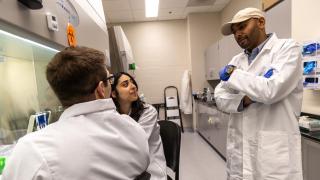
Educational Technology Professor Stein Brunvand is a big fan of one-credit courses. From a student’s perspective, they can save time and money if someone’s aiming to hit a very specific credit-hour total for financial aid requirements. And they can give a student a super-efficient way to explore a topic without committing to a full semester’s worth of coursework. From his side of things, Brunvand really likes having the ability to work timely, emerging topics into the curriculum. Plus, changing things up keeps his own work life interesting.
Brunvand has been offering these kinds of five-week mini-courses for years now, and enrollment can vary quite a bit. But interest surged for the two courses he taught this semester: “Creating a Makerspace” and “The Educational Escape Room.” In both, but especially in the latter, Brunvand was also surprised to see a decent share of the students weren’t education majors. “In the Escape Room class, we had a lot of people from CASL, we had a couple computer science folks, even some folks from engineering,” he says. “And we actually had a wait list, which has never happened.”
Part of the reason for the strong interest in that course may be that it was simply a pretty cool class concept. The core mission: Learning to adapt the puzzle-focused escape room formula to everyday spaces, with a capstone project that involved creating a full escape room experience. For education students, Brunvand says the hope was to design something that could be used in their K-12 classrooms, especially for teaching things like problem solving, critical thinking and teamwork. For students coming from other disciplines, he broadened their assignments a bit so they could design escape rooms for things like employee team building activities.
It sounds fun enough, but building a series of puzzles that also features a strong storyline, which Brunvand says is the essence of a really good escape room, is actually a pretty stiff challenge. “For some students, their instincts were to design challenges that basically asked questions. But ‘what ocean borders Florida?’ is not a puzzle. That’s a question, and if you simply have the correct information or even Google it, you have the answer. A good puzzle is built on logic; it requires using reason to discover links between clues. So that’s a pretty complicated concept to wrap your mind around, but I think students had a lot of fun once they got the hang of it.”
Challenge design was also at the heart of Brunvand’s Makerspace mini-course. The final project was to design a $3,000 makerspace for your classroom (or other setting), plus an activity your students could do using the materials you stocked it with. As in the escape room course, the activity had to leave plenty of room for problem solving, teamwork and critical thinking.
“The idea is that you give the students all the same challenge and the same parameters, but how they work through the challenge is something they have to figure out themselves,” Brunvand says. “This way, the students get to learn through trial and error. That’s actually a pretty rare kind of learning experience. Usually, your grade depends on getting the right answer and the wrong answer doesn’t count at all. But when you’re engaged in a design process where getting to the right answer requires getting things wrong a few times and learning from that, the error part actually counts a lot.”
Ed.D. student and Hazel Park special educator Megan Papasian-Broadwell, who took Brunvand’s makerspace course, says that’s an ethos that’s often overlooked in the special education experience. “For our students with exceptional abilities, I see that sometimes they’re afraid to take risks and afraid to be wrong,” she says. “They have so much supervision — in almost every part of their lives — it’s hard for them to take risks and be problem solvers. It’s also hard for many special educators because they want to do everything possible to help and support their students.”
For that reason, Papasian-Broadwell’s final project — a version of the popular marshmallow challenge — included a very specific design element: support staff could only help students by answering yes-or-no questions. That ensured the students would have to do the heavy lifting in engineering their marshmallow towers. Going forward, she plans to incorporate some of the same principles in her work with young adult learners — many of whom are involved in a hands-on microbusiness program, where they are currently making protective masks and working in greenhouses.
Brunvand is happy to see that students got a lot out of this semester’s mini-courses, and he’s already preparing his next set of offerings. First up, this summer he’ll be reviving a one-credit class on creating online learning experiences that was a hit with students last summer. Without a doubt, there will be many more to come.
###
Story by Lou Blouin. If you’re a member of the media and would like to interview Professor Stein Brunvand about this topic, drop us a line at [email protected].





